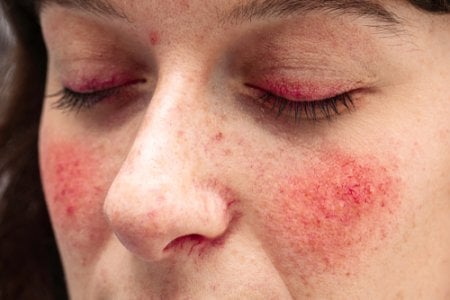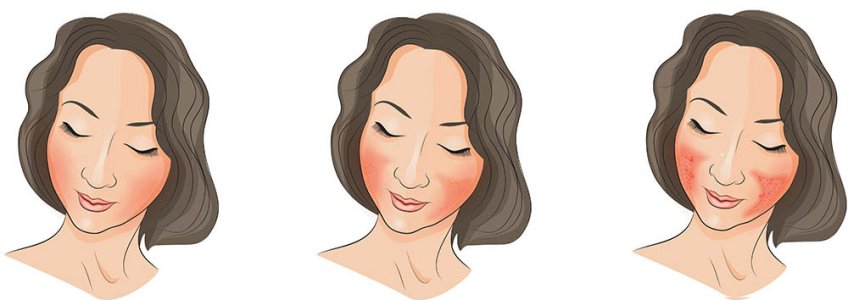Embarrassed by a red face? Doctor reveals truth behind facial flushing
A red face at the wrong time can be a source—and a sign—of embarrassment and discomfort for many.
Whether during a social event, a family gathering, or even a casual conversation, facial flushing can strike without warning, leaving people feeling exposed and sometimes even mistakenly accused of having had one too many drinks.
This is the case for Elise, who reached out to a doctor named Zac Turner in his weekly column, Ask Doctor Zac, about her condition.
She wrote: ‘Hi Dr Zac, I have a red nose and my husband says it’s because I drink too much alcohol—but I’ve actually cut back recently. He tells me that I look like Rudolph the red-nosed reindeer! What’s the cause?’
‘I lead a pretty healthy life, and I'm not overweight. How can I get rid of it so I don’t get accused of being an alcoholic?’ she asked.
Dr Zac, who has a Bachelor of Medicine and Bachelor of Surgery from the University of Sydney, responded and elaborated on her condition, identifying it as skin flushing or blushing.
‘Whenever blood flows to an area of skin, such as your nose, the blood vessels enlarge to compensate. This is what gives the red effect,’ he explained.
Dr Zac also explained the two types of blushing: wet and dry.
‘Wet blushing is caused by an overactive sympathetic nervous system. This is the body’s system for regulating glands and organs, and controls the diameter of blood vessels,’ he said.
‘For some people, this system is particularly sensitive to emotional stress. This is why some people get so red in the face and neck when they are embarrassed,’ Dr Zac elaborated.
Dry blushing, on the other hand, is driven by increased levels of certain chemicals in the bloodstream.
These are naturally occurring substances like nitric oxide and hormones such as adrenaline and histamine, which boost blood flow to certain oxygen or nutrient-depleted areas of the body. Emotional stress can trigger this reaction, too.
It’s important to note that alcohol might indeed trigger red flushing, known as 'alcohol intolerance'.
Dr Zac stated: ‘It’s caused by an inherited deficiency of the aldehyde dehydrogenase 2 (ALDH2) enzyme. This enzyme is needed to break down alcohol.’
Equally, this redness is common in women experiencing menopause.
Speaking to Elise, Dr Zac said: ‘I would recommend you reach out to a dermatologist if this flushing continues, as it could also be acne or rosacea.’
‘This is a condition that’s hard to initially diagnose as the early symptoms are confused with blushing. It’s a progressive skin condition. This means that it may become worse without proper treatment,’ he continued.
‘In rosacea, blood vessels in your face enlarge, allowing more blood to flow into your cheeks,’ he shared.
According to Healthdirect, rosacea is more common in females aged between 30 to 50 years.
Dr Zac also mentioned other reasons for red skin flushing, which are allergies, sunburn, viral rash, or fever.
The good news is there are ways to control the redness.
He shared: ‘Unfortunately, our skin is an intricate organ. It’s highly complex so prevention can be very fickle. You can always mitigate hot flushes by limiting alcohol intake, spicy foods and spending too much time in either hot or cold temperatures.’
He also gave these skin care tips:
However, it's always best to consult a healthcare provider if you're concerned about repeated episodes. Your general practitioner (GP) or a dermatologist is well-positioned to diagnose the reasons behind your facial flushing and treat them.
Ultimately, getting to the root of flush triggers is the key to effective blushing remedies.
 Have you dealt with similar skin concerns, members? How have you managed it? We'd love to hear your stories and tips below in the comments!
Have you dealt with similar skin concerns, members? How have you managed it? We'd love to hear your stories and tips below in the comments!
Whether during a social event, a family gathering, or even a casual conversation, facial flushing can strike without warning, leaving people feeling exposed and sometimes even mistakenly accused of having had one too many drinks.
This is the case for Elise, who reached out to a doctor named Zac Turner in his weekly column, Ask Doctor Zac, about her condition.
She wrote: ‘Hi Dr Zac, I have a red nose and my husband says it’s because I drink too much alcohol—but I’ve actually cut back recently. He tells me that I look like Rudolph the red-nosed reindeer! What’s the cause?’
‘I lead a pretty healthy life, and I'm not overweight. How can I get rid of it so I don’t get accused of being an alcoholic?’ she asked.
Dr Zac, who has a Bachelor of Medicine and Bachelor of Surgery from the University of Sydney, responded and elaborated on her condition, identifying it as skin flushing or blushing.
‘Whenever blood flows to an area of skin, such as your nose, the blood vessels enlarge to compensate. This is what gives the red effect,’ he explained.
Dr Zac also explained the two types of blushing: wet and dry.
‘Wet blushing is caused by an overactive sympathetic nervous system. This is the body’s system for regulating glands and organs, and controls the diameter of blood vessels,’ he said.
‘For some people, this system is particularly sensitive to emotional stress. This is why some people get so red in the face and neck when they are embarrassed,’ Dr Zac elaborated.
Dry blushing, on the other hand, is driven by increased levels of certain chemicals in the bloodstream.
These are naturally occurring substances like nitric oxide and hormones such as adrenaline and histamine, which boost blood flow to certain oxygen or nutrient-depleted areas of the body. Emotional stress can trigger this reaction, too.
It’s important to note that alcohol might indeed trigger red flushing, known as 'alcohol intolerance'.
Dr Zac stated: ‘It’s caused by an inherited deficiency of the aldehyde dehydrogenase 2 (ALDH2) enzyme. This enzyme is needed to break down alcohol.’
Equally, this redness is common in women experiencing menopause.
Speaking to Elise, Dr Zac said: ‘I would recommend you reach out to a dermatologist if this flushing continues, as it could also be acne or rosacea.’
‘This is a condition that’s hard to initially diagnose as the early symptoms are confused with blushing. It’s a progressive skin condition. This means that it may become worse without proper treatment,’ he continued.
‘In rosacea, blood vessels in your face enlarge, allowing more blood to flow into your cheeks,’ he shared.
According to Healthdirect, rosacea is more common in females aged between 30 to 50 years.
Dr Zac also mentioned other reasons for red skin flushing, which are allergies, sunburn, viral rash, or fever.
The good news is there are ways to control the redness.
He shared: ‘Unfortunately, our skin is an intricate organ. It’s highly complex so prevention can be very fickle. You can always mitigate hot flushes by limiting alcohol intake, spicy foods and spending too much time in either hot or cold temperatures.’
He also gave these skin care tips:
- Wash your face gently but regularly with a mild cleanser and dry it by patting.
- Try a calming face mask, but discard it if the redness worsens.
- Guard against prolonged sunlight exposure; the sun can inflame already reddened skin.
- If heading out, green-tinted makeup or foundation can temporarily mask the redness.
However, it's always best to consult a healthcare provider if you're concerned about repeated episodes. Your general practitioner (GP) or a dermatologist is well-positioned to diagnose the reasons behind your facial flushing and treat them.
Ultimately, getting to the root of flush triggers is the key to effective blushing remedies.
Key Takeaways
- Facial flushing could be a symptom of various conditions and is often due to increased blood flow to the affected area, resulting in the appearance of redness.
- Alcohol intolerance, menopause, acne, rosacea, allergies, sunburn, viral rash, or fever are some common causes of facial flushing.
- To manage redness, skin care tips such as gentle cleansing, avoiding harsh sunlight, and using calming face masks and green-tinted makeup are recommended.
- Reaching out to a GP or dermatologist for a proper diagnosis and treatment is advisable for chronic or concerning facial redness.










